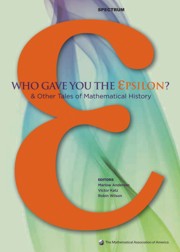Book contents
- Frontmatter
- Introduction
- Contents
- Analysis
- Geometry, Topology and Foundations
- Algebra and Number Theory
- Foreword
- Hamilton's Discovery of Quaternions
- Hamilton, Rodrigues, and the Quaternion Scandal
- Building an International Reputation: The Case of J. J. Sylvester (1814–1897)
- The Foundation Period in the History of Group Theory
- The Evolution of Group Theory: A Brief Survey
- The Search for Finite Simple Groups
- Genius and Biographers: The Fictionalization of Evariste Galois
- Hermann Grassmann and the Creation of Linear Algebra
- The Roots of Commutative Algebra in Algebraic Number Theory
- Eisenstein's Misunderstood Geometric Proof of the Quadratic Reciprocity Theorem
- Waring's Problem
- A History of the Prime Number Theorem
- A Hundred Years of Prime Numbers
- The Indian Mathematician Ramanujan
- Emmy Noether
- “ Marvelous Proof,”
- Afterword
- Surveys
- Index
- About the Editors
Genius and Biographers: The Fictionalization of Evariste Galois
from Algebra and Number Theory
- Frontmatter
- Introduction
- Contents
- Analysis
- Geometry, Topology and Foundations
- Algebra and Number Theory
- Foreword
- Hamilton's Discovery of Quaternions
- Hamilton, Rodrigues, and the Quaternion Scandal
- Building an International Reputation: The Case of J. J. Sylvester (1814–1897)
- The Foundation Period in the History of Group Theory
- The Evolution of Group Theory: A Brief Survey
- The Search for Finite Simple Groups
- Genius and Biographers: The Fictionalization of Evariste Galois
- Hermann Grassmann and the Creation of Linear Algebra
- The Roots of Commutative Algebra in Algebraic Number Theory
- Eisenstein's Misunderstood Geometric Proof of the Quadratic Reciprocity Theorem
- Waring's Problem
- A History of the Prime Number Theorem
- A Hundred Years of Prime Numbers
- The Indian Mathematician Ramanujan
- Emmy Noether
- “ Marvelous Proof,”
- Afterword
- Surveys
- Index
- About the Editors
Summary
1 Introduction
In Paris, on the obscure morning of May 30, 1832, near a pond not far from the pension Sieur Faultrier, Evariste Galois confronted Pescheux d'Herbinville in a duel to be fought with pistols, and was shot through the stomach. Hours later, lying wounded and alone, Galois was found by a passing peasant. He was taken to the Hospital Cochin where he died the following day in the arms of his brother Alfred, after having refused the services of a priest. Had Galois lived another five months, until October 25, he would have attained the age of twenty-one.
The legend of Evariste Galois, creator of group theory, has fired the imagination of generations of mathematics students. Many of us have experienced the excitement of Freeman Dyson who writes ([8], p. 14):
In those days, my head was full of the romantic prose of E. T. Bell's Men of Mathematics, a collection of biographies of the great mathematicians. This is a splendid book for a young boy to read (unfortunately, there is not much in it to inspire a girl, with Sonya Kovalevsky allotted only half a chapter), and it has awakenedmany people of my generation to the beauties of mathematics. The most memorable chapter is called “Genius and Stupidity” and describes the life and death of the French mathematician Galois, who was killed in a duel at the age of twenty.
Dyson goes on to quote Bell's famous description ([1], p. 375) of Galois's last night before the duel:
- Type
- Chapter
- Information
- Who Gave You the Epsilon?And Other Tales of Mathematical History, pp. 271 - 290Publisher: Mathematical Association of AmericaPrint publication year: 2009



